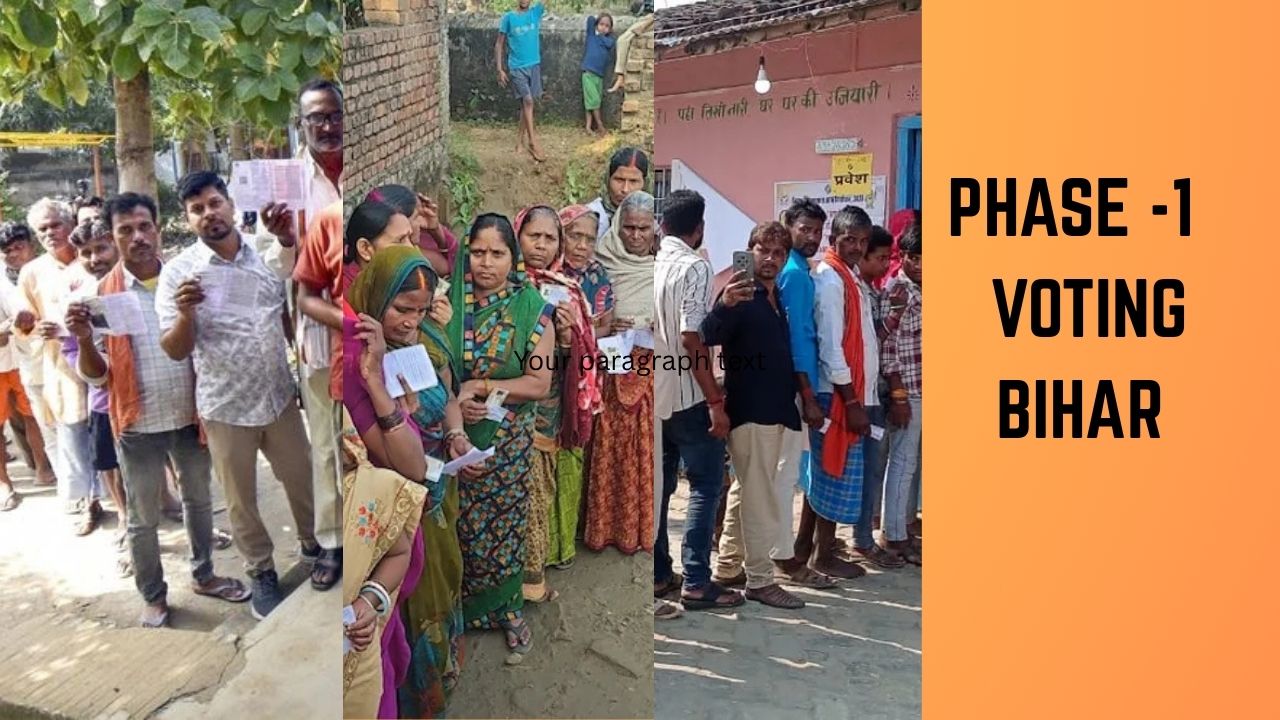Poonam Sharma
The first phase of Bihar’s 2025 assembly election, covering 121 constituencies across 18 districts, produced turnout patterns that matter more for strategy than for immediate seat projection. The Election Commission’s and CEO-Bihar snapshots recorded a mid-day state-wide turnout of about 42% (till 1 pm) and then a higher consolidated snapshot of 53.77% till 3 pm, underscoring a steady voting pace across the day rather than a single surge.
Geography and demography shaped participation.
Rural districts like Begusarai, Gopalganj, Muzaffarpur, and Lakhisarai among those registering comparatively strong early participation, while Patna consistently trailed others in early hours — Patna recorded only ~11–24% in the early time slices (9am → 11am) indicating heavier urban apathy or later-day turnout concentration. District turnout, according to the time-stamped VTRs released by the CEO, averaged ~13.13% at 9:00 am across the Phase-1 footprint and rose to ~27.65% by 11:00 am, thus showing a healthy intraday pick-up.
At the constituency level, live reporting from Minapur flagged it as an outlier high turnout pocket-reported to be around 64.7% by 3 pm Begusarai district among the highest overall by the same round. This is politically consequential because high rural turnouts often benefit well-organized grassroots machines with strong booth-level mobilization. On the other hand, lower urban turnout-a trend across Patna pockets such as Bankipur, Kumhrar, Patna Sahib-can dampen the prospects of parties dependent on the urban swing factor.
What do these patterns mean for parties and campaigns?
First, the steady rise in turnout through the day suggests effective booth management and mobilization in rural areas. Parties that have invested in block- and booth-level organisations — typically parties with long local networks — are likely to convert high turnout into seat gains in closely contested rural seats. Second, urban low turnout is a double-edged sword: it reduces the absolute number of votes available to urban-centrist challengers but also magnifies the influence of motivated voter bases — cadres, community blocs — who do turn up.
Updated Analysis (with constituency-level turnout integration)
Overview
Phase 1 of the Bihar Assembly Elections 2025, held on 6 November 2025, recorded an overall voter turnout of around 53.77% by 3 PM, as per Election Commission updates. A total of 121 constituencies across 18 districts went to the polls, including politically sensitive belts like Begusarai, Darbhanga, Muzaffarpur, Nalanda, Patna, and Khagaria.
While the overall participation was moderate, micro-level data reveal a more nuanced picture — especially in industrial and semi-urban constituencies of Begusarai district, where turnout hovered in the low-30s, indicating urban fatigue and weak mobilization.
District Spotlight — Begusarai Region
The Begusarai district zone, often considered a bellwether for north-central Bihar, showed subdued participation averaging just around 32% across most of its constituencies by late afternoon:
Constituency Approx. Turnout (%) Remarks
Teghra 32% Left-wing stronghold with historically disciplined but limited cadre turnout.
Matihani 31% Industrial periphery seat; voter enthusiasm dampened by migratory workforce absenteeism.
Cheria Bariarpur 33% Semi-rural zone; higher female turnout partially balanced low youth participation.
Begusarai (Main) 32% Urban seat with polarization fatigue; middle-class voter apathy visible.
Bachhwara 33% Agrarian-dominated seat; decent rural mobilization prevented further dip.
Bakhri (SC) 33% SC-reserved constituency; strong turnout among women but weaker youth presence.
These figures reveal that Begusarai’s average turnout (≈ 32–33%) was 20 points lower than the statewide average (~53.7%).
This stark gap underlines a clear urban–rural divergence: while agrarian constituencies in Madhepura, Gopalganj, and Khagaria touched 55–60%, the industrial–urban belt lagged sharply behind.
Analytical Takeaways
Industrial belt fatigue:
Constituencies such as Teghra and Matihani, characterized by factory closures and heavy out-migration, continue to show voter disengagement. The low 31–32% turnout hints at both logistical absenteeism and psychological alienation from local politics.
Gender gap in participation:
Preliminary booth feedback suggests women’s turnout held steadier (sometimes exceeding 35%) even where male participation dropped. Welfare-linked voting behavior remains stronger among female voters.
Impact on party prospects:
CPI and Left-aligned alliances, which traditionally rely on cadre-based mobilization in Teghra–Bakhri belt, may sustain vote share despite low absolute numbers.
BJP–JD(U) bloc, more dependent on floating urban votes, risks losing momentum where turnout is depressed.
RJD and allies could benefit in adjacent rural zones if they maintained village-level booth operations and ensured female voter turnout.
Contrast with rural zones:
Compared with the 64.7% turnout in Minapur and nearly 60% in several north Bihar constituencies, Begusarai’s sub-35% numbers drag down the district’s overall influence on the Phase-1 turnout index.
Urban apathy and political messaging:
Repeated low turnouts across Patna, Begusarai, and Munger highlight a pattern — educated, industrial-urban populations increasingly see elections as ceremonial rather than change-driven. Parties will have to re-engineer their outreach strategy for the second phase, emphasizing tangible employment and infrastructure agendas instead of pure rhetoric.
Broader Phase-1 Snapshot
Average state turnout: ~53.77% (by 3 PM)
Peak performer: Minapur (≈ 64.7%)
Urban laggard: Patna ≈ 38%–40% range
Low-performing industrial belt: Begusarai cluster ≈ 32% average
Women’s turnout: slightly higher than men in most rural areas
Polling incidents: largely peaceful with minor EVM delays reported in 14 booths statewide
Conclusion
The first phase of Bihar’s 2025 assembly elections paints a dual narrative — vibrant rural democracy versus muted industrial urban participation. The Begusarai-Matihani-Teghra belt’s turnout stagnation near 32% is emblematic of an underlying disconnection between political promises and ground realities in industrial Bihar.
If subsequent phases fail to lift participation in these economic centers, Bihar’s overall voter engagement may stagnate below 55%, shaping a mandate driven disproportionately by rural voters.
As the campaign moves toward Phase 2, political parties will likely recalibrate — emphasizing rural consolidation and targeted urban re-engagement — to bridge the turnout gap visible so clearly in these first-phase numbers.

